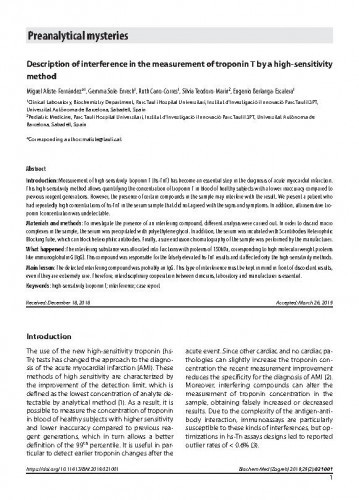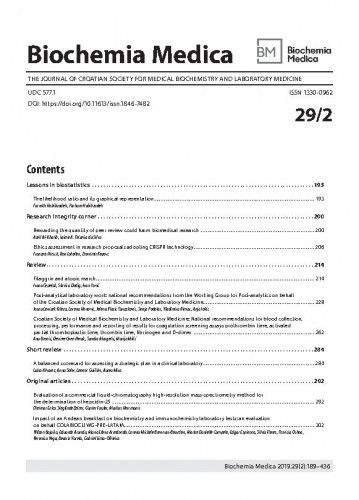Measurement of high-sensitivity troponin T (hs-TnT) has become an essential step in the diagnosis of acute myocardial infarction.This high-sensitivity method allows quantifying the concentration of troponin T in blood of healthy subjects with a lower inaccuracy compared toprevious reagent generations. However, the presence of certain compounds in the sample may interfere with the result. We present a patient whohad repeatedly high concentrations of hs-TnT in the serum sample that did not agreed with the signs and symptoms. In addition, ultrasensitive troponinI concentration was undetectable.Materials and methods: To investigate the presence of an interfering compound, different analysis were carried out. In order to discard macrocomplexes in the sample, the serum was precipitated with polyethylene glycol. In addition, the serum was incubated with Scantibodies HeterophilicBlocking Tube, which can block heterophilic antibodies. Finally, a size exclusion chromatography of the sample was performed by the manufacturer.What happened: The interfering substance was allocated into fractions with proteins of 150kDa, corresponding to high molecular weight proteinslike immunoglobulin G (IgG). This compound was responsible for the falsely elevated hs-TnT results and it affected only the high-sensitivity methods.Main lesson: The detected interfering compound was probably an IgG. This type of interference must be kept in mind in front of discordant results,even if they are extremely rare. Therefore, interdisciplinary cooperation between clinicians, laboratory and manufacturer is essential.
Sažetak

 Biochemia medica : the journal of Croatian Society for Medical Biochemistry and Laboratory Medicine : 29,2(2019) / glavna i odgovorna urednica Daria Pašalić.
Biochemia medica : the journal of Croatian Society for Medical Biochemistry and Laboratory Medicine : 29,2(2019) / glavna i odgovorna urednica Daria Pašalić.